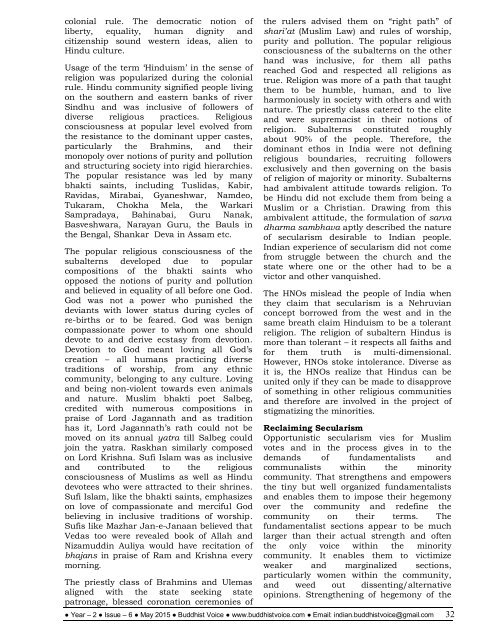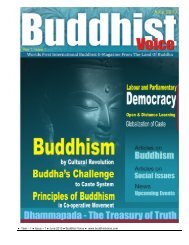BV - May 2015 Yr 2 Issue 6 E
Create successful ePaper yourself
Turn your PDF publications into a flip-book with our unique Google optimized e-Paper software.
colonial rule. The democratic notion of<br />
liberty, equality, human dignity and<br />
citizenship sound western ideas, alien to<br />
Hindu culture.<br />
Usage of the term ‘Hinduism’ in the sense of<br />
religion was popularized during the colonial<br />
rule. Hindu community signified people living<br />
on the southern and eastern banks of river<br />
Sindhu and was inclusive of followers of<br />
diverse religious practices. Religious<br />
consciousness at popular level evolved from<br />
the resistance to the dominant upper castes,<br />
particularly the Brahmins, and their<br />
monopoly over notions of purity and pollution<br />
and structuring society into rigid hierarchies.<br />
The popular resistance was led by many<br />
bhakti saints, including Tuslidas, Kabir,<br />
Ravidas, Mirabai, Gyaneshwar, Namdeo,<br />
Tukaram, Chokha Mela, the Warkari<br />
Sampradaya, Bahinabai, Guru Nanak,<br />
Basveshwara, Narayan Guru, the Bauls in<br />
the Bengal, Shankar Deva in Assam etc.<br />
The popular religious consciousness of the<br />
subalterns developed due to popular<br />
compositions of the bhakti saints who<br />
opposed the notions of purity and pollution<br />
and believed in equality of all before one God.<br />
God was not a power who punished the<br />
deviants with lower status during cycles of<br />
re-births or to be feared. God was benign<br />
compassionate power to whom one should<br />
devote to and derive ecstasy from devotion.<br />
Devotion to God meant loving all God’s<br />
creation – all humans practicing diverse<br />
traditions of worship, from any ethnic<br />
community, belonging to any culture. Loving<br />
and being non-violent towards even animals<br />
and nature. Muslim bhakti poet Salbeg,<br />
credited with numerous compositions in<br />
praise of Lord Jagannath and as tradition<br />
has it, Lord Jagannath’s rath could not be<br />
moved on its annual yatra till Salbeg could<br />
join the yatra. Raskhan similarly composed<br />
on Lord Krishna. Sufi Islam was as inclusive<br />
and contributed to the religious<br />
consciousness of Muslims as well as Hindu<br />
devotees who were attracted to their shrines.<br />
Sufi Islam, like the bhakti saints, emphasizes<br />
on love of compassionate and merciful God<br />
believing in inclusive traditions of worship.<br />
Sufis like Mazhar Jan-e-Janaan believed that<br />
Vedas too were revealed book of Allah and<br />
Nizamuddin Auliya would have recitation of<br />
bhajans in praise of Ram and Krishna every<br />
morning.<br />
The priestly class of Brahmins and Ulemas<br />
aligned with the state seeking state<br />
patronage, blessed coronation ceremonies of<br />
the rulers advised them on “right path” of<br />
shari’at (Muslim Law) and rules of worship,<br />
purity and pollution. The popular religious<br />
consciousness of the subalterns on the other<br />
hand was inclusive, for them all paths<br />
reached God and respected all religions as<br />
true. Religion was more of a path that taught<br />
them to be humble, human, and to live<br />
harmoniously in society with others and with<br />
nature. The priestly class catered to the elite<br />
and were supremacist in their notions of<br />
religion. Subalterns constituted roughly<br />
about 90% of the people. Therefore, the<br />
dominant ethos in India were not defining<br />
religious boundaries, recruiting followers<br />
exclusively and then governing on the basis<br />
of religion of majority or minority. Subalterns<br />
had ambivalent attitude towards religion. To<br />
be Hindu did not exclude them from being a<br />
Muslim or a Christian. Drawing from this<br />
ambivalent attitude, the formulation of sarva<br />
dharma sambhava aptly described the nature<br />
of secularism desirable to Indian people.<br />
Indian experience of secularism did not come<br />
from struggle between the church and the<br />
state where one or the other had to be a<br />
victor and other vanquished.<br />
The HNOs mislead the people of India when<br />
they claim that secularism is a Nehruvian<br />
concept borrowed from the west and in the<br />
same breath claim Hinduism to be a tolerant<br />
religion. The religion of subaltern Hindus is<br />
more than tolerant – it respects all faiths and<br />
for them truth is multi-dimensional.<br />
However, HNOs stoke intolerance. Diverse as<br />
it is, the HNOs realize that Hindus can be<br />
united only if they can be made to disapprove<br />
of something in other religious communities<br />
and therefore are involved in the project of<br />
stigmatizing the minorities.<br />
Reclaiming Secularism<br />
Opportunistic secularism vies for Muslim<br />
votes and in the process gives in to the<br />
demands of fundamentalists and<br />
communalists within the minority<br />
community. That strengthens and empowers<br />
the tiny but well organized fundamentalists<br />
and enables them to impose their hegemony<br />
over the community and redefine the<br />
community on their terms. The<br />
fundamentalist sections appear to be much<br />
larger than their actual strength and often<br />
the only voice within the minority<br />
community. It enables them to victimize<br />
weaker and marginalized sections,<br />
particularly women within the community,<br />
and weed out dissenting/alternative<br />
opinions. Strengthening of hegemony of the<br />
● Year – 2 ● <strong>Issue</strong> – 6 ● <strong>May</strong> <strong>2015</strong> ● Buddhist Voice ● www.buddhistvoice.com ● Email: indian.buddhistvoice@gmail.com 32



